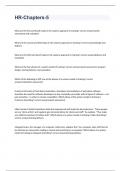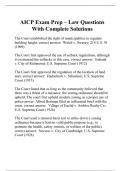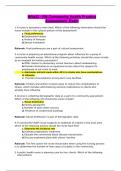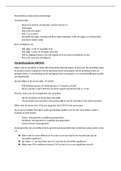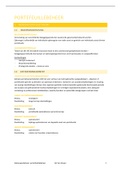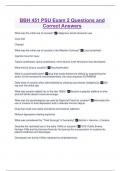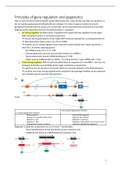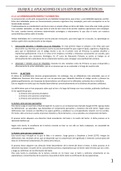Typical exam questions
- Currently, vegetable marketers are all advertising about product naturalness.
- Based on these results, what would be your marketing recommendation for
differentiation?
,Session 1
Research
Exploratory: discovering new things which may lead to think of new
hypotheses.
Confirmatory: testing hypotheses.
Data
Primary: interviews, surverys, experiments.
Secondary: government data, online data.
Data Analysis
Qualitative:
Quantitative
Descriptive statistics
Mean = average.
Determines the size of the histogram bar.
Measures of variability
1. Standard deviation:
= On average, how far is 1 value from the mean?
SD determines the size of the error bar.
2. Standard error
SE = σ / √n
You can compare the standard error to other groups.
It is less influenced by group size.
3. 95% CI
Frequencies
Frequency = the number of times that the event occurs.
Raw frequency: 2 times.
Relative frequency: 2 times / 8 times in total = 25%.
Mode = most frequent observation.
Boxplot
Q1 = first quartile = 25th percentile (25% of data falls below this point)
Median = 50th percentile.
Q3 = third quartile 75th percentile (75% of data falls below this point.
IQR = Q3 – Q1 used to determine outliers. Often: +/- 1,5*IQR.
,In R:
Always: database$variable
A value = numeric or character (if written between ‘’quotation marks‘’).
Vector = several values (row or column). To create: vec1 <- c(‘’Ams’’, ‘’Rot’’).
Data frame = several rows and columns. To create: df1 <-
data.frame(vec1,vec2).
To get a mean, SD or median
mean(database$variable)
sd(database$variable)
median(database$variable)
To get a summary (min, Q1, median, mean, Q3, max)
> summary(listings$price)
Min. 1st Qu. Median Mean 3rd Qu. Max.
0.0 95.0 129.0 156.1 180.0 8000.0
To create a boxplot
boxplot(listings$price,
ylim=c(0,1000),
range=1.5)
0 = y-minimum
1000 = y-maximum
Range is to see the boxplot better, often 1,5 is the chosen range to set the
minimum and maximum. Ylim sets the values on the axes.
Q1 – 1,5*IQR
Q3 + 1,5*IQR.
To set the low cutoff value for outliers:
outlier_low_val <- q1 – 1.5 * IQR
, Missing values? This might impact certain functions (e.g. mean).
Use na.rm=TRUE to ignore missing values
If you want the data in increasing or decreasing order:
decreasing=FALSE
decreasing=TRUE
E.g. sort(table1, decreasing=TRUE).
To create a histogram
hist(listings$availabiltiy_365, breaks=100)
Other functions
sqrt = square root
nchar = number of characters
head = top 6 lines of listing
table(database$variable) = to create a table with raw frequencies
prop.table(objectname) = to get relative frequencies
round(mean(database$variable),0) = to round values (here rounded on 0
decimals).
IQR(database$variable) = to get IQR.
Quantile(database$variable, 0.25) = to get Q1.
Quantile(database$variable, 0.75) = to get Q3.

